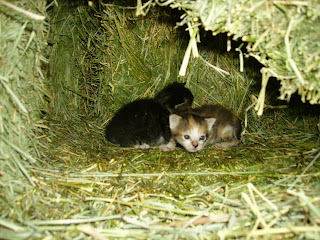
The honey bee's nature is to fill any void. So, when I removed two frames to accommodate the queen's travel container, they filled the empty space with burr comb that hung down from the hive's lid. In order to put the frame back, I had to scraped them off and I imagined their frustration after creating such a work or art to have it destroyed.

***************
The hives had sat for a week after I had released the queen before we had time to check to see, if their highnesses had created any offspring which is called brood at the larvae stage. Kirk was off work and so on Friday he suited up and took a look. One hive didn't have very many bees in residence and there was no brood, a good sign that their queen had died shortly after she was released. Rather than have a new one rushed to us, we decided to move the bees into the hive with the fewest occupants. We figured we'd do this the next day when we relocated them to the Durham Buffalo Ranch, just outside of town.Right now, it was afternoon, the best time to visit the inside of a hive since most of the workers are visiting blossoms and their are fewer bees at home to disturb. To relocate them, we needed everyone, so we waited until the sun went down and the cooler temperature drove the bees scurrying for the warmth of their hive. This gave us time to go and do livestock chores and when we returned, the first thing we did was tape the hive's openings with good ole duck tape to prevent a war that would surely ensue when we jostled their boxes heave hoeing them into the pickup bed. It wasn't much consolation that the workers would lose their lives as their stinger penetrated our hide and was ripped from their bodies. Especially as I was still recovering from the three stings inflicted upon my neck the previous week.
With their escape blocked, we worked as a team stretching duck tape around each hive straddling the boxes to hold them together so they wouldn't separate. With the hives sitting in a row across the back of the pickup bed, Kirk placed cinder blocks on top each hive lid and began cinching a strap across them to make sure they didn't move during the bumpy ride into the pasture, early the next morning. I headed for the house wondering what we'd have for supper since it was late and an early morning was ahead of us. As I reached the garage, I called back to Kirk, "Don't forget to rip the tape off the openings so they'll have plenty of oxygen tonight."

The sun was just creeping over the horizon Saturday morning when we re-taped the openings and drove the ten miles to the pasture. The wind had a bite to it and we were bundled in sweatshirts and winter coats as we set down the hives near a haystack and ripped the tape off the openings. Then, we returned home for the cow panels to form a fence to discourage the buffalo from rubbing on the boxes and knocking them over, which has happened once before. We were lucky that time. The bees had swarmed onto a nearby fence post and we were able to scoop them up and place them once more in their reassembled hive before they flew off without leaving a forwarding address.
The cow panels took only a few minutes to erect and Kirk and I put on our bee veils and gloves to add a couple honey storage boxes for each hive and shift the bees from the hive without a queen to the one next to it. As we did so, we talked about the seven head of elk we'd discovered on the hillside when we walked the pasture checking out the vegetation on Mother's Day. It was awesome to see them return to the plains where they were once plentiful and we hoped to glimpse then again when we visited the hives throughout the summer. Finished, we headed for the house to start our livestock chores, our own stomaches rumbling with neglect.
 Bibb's kittens in the hay barn.
Bibb's kittens in the hay barn.
No comments:
Post a Comment